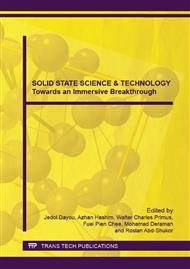[1]
X. Liu, X. Piao, Y. Wang, and S. Zhu, Calcium Ethoxide as a Solid Base Catalyst for the Transesterification of Soybean Oil to Biodiesel, no. July 2007, p.1313–1317, (2008).
DOI: 10.1021/ef700518h
Google Scholar
[2]
R. Rinaldi and F. Sch, Design of solid catalysts for the conversion of biomass, p.610–626, (2009).
Google Scholar
[3]
Y. W. Wang, L. D. Zhang, G. Z. Wang, X. S. Peng, Z. Q. Chu, and C. H. Liang, Catalytic growth of semiconducting zinc oxide nanowires and their photoluminescence properties, J. Cryst. Growth, vol. 234, no. 1, p.171–175, (2002).
DOI: 10.1016/s0022-0248(01)01661-x
Google Scholar
[4]
M. A. Sayyadnejad, H. R. Ghaffarian, and M. Saeidi, Removal of hydrogen sulfide by zinc oxide nanoparticles in drilling fluid, vol. 5, no. 4, p.565–569, (2008).
DOI: 10.1007/bf03326054
Google Scholar
[5]
N. P. Ariyanto, H. Abdullah, S. Shaari, S. Junaidi, and B. Yuliarto, Preparation and Characterisation of Porous Nanosheets Zinc Oxide Films : Based on Chemical Bath Deposition, vol. 6, no. 6, p.764–768, (2009).
Google Scholar
[6]
A. C. Alba-Rubio, J. Santamaría-González, J. M. Mérida-Robles, R. Moreno-Tost, D. Martín-Alonso, A. Jiménez-López, and P. Maireles-Torres, Heterogeneous transesterification processes by using CaO supported on zinc oxide as basic catalysts, Catal. Today, vol. 149, no. 3–4, p.281–287, Jan. (2010).
DOI: 10.1016/j.cattod.2009.06.024
Google Scholar
[7]
Y. Liu, J. Zhou, A. Larbot, and M. Persin, Preparation and characterization of nano-zinc oxide, vol. 189, p.379–383, (2007).
DOI: 10.1016/j.jmatprotec.2007.02.007
Google Scholar
[8]
M. Sivakumar, A. Towata, K. Yasui, T. Tuziuti, and Y. Iida, Ultrasonic Cavitational Activation: A Simple and Feasible Route for the Direct Conversion of Zinc Acetate to Highly Monodispersed ZnO, Chem. Lett., vol. 35, no. 1, p.60–61, (2006).
DOI: 10.1246/cl.2006.60
Google Scholar
[9]
W. -W. Wang and Y. -J. Zhu, Synthesis of Needle-like and Flower-like Zinc Oxide by a Simple Surfactant-free Solution Method, Chem. Lett., vol. 33, no. 8, p.988–989, (2004).
DOI: 10.1246/cl.2004.988
Google Scholar
[10]
A. P. A. Oliveira, Controlled Precipitation of Zinc Oxide Particles at Room Temperature, no. 20, p.3202–3207, (2003).
Google Scholar
[11]
M. J. Coutts, H. M. Zareie, M. B. Cortie, M. R. Phillips, R. Wuhrer, and A. M. McDonagh, Exploiting zinc oxide re-emission to fabricate periodic arrays., ACS Appl. Mater. Interfaces, vol. 2, no. 6, p.1774–9, Jun. (2010).
DOI: 10.1021/am100284v
Google Scholar
[12]
S. Cho, J. -W. Jang, A. Jung, S. -H. Lee, J. Lee, J. S. Lee, and K. -H. Lee, Formation of amorphous zinc citrate spheres and their conversion to crystalline ZnO nanostructures., Langmuir, vol. 27, no. 1, p.371–8, Jan. (2011).
DOI: 10.1021/la103600c
Google Scholar
[13]
X. Gao, X. Li, and W. Yu, Flowerlike ZnO nanostructures via hexamethylenetetramine-assisted thermolysis of zinc-ethylenediamine complex., J. Phys. Chem. B, vol. 109, no. 3, p.1155–61, Jan. (2005).
DOI: 10.1021/jp046267s
Google Scholar
[14]
S. Hirano, K. Masuya, and M. Kuwabara, Multi-Nucleation-Based Formation of Oriented Zinc Oxide Microcrystals and Films in Aqueous Solutions, J. Phys. Chem. B, vol. 108, no. 15, p.4576–4578, Apr. (2004).
DOI: 10.1021/jp038014p
Google Scholar
[15]
S. J. Ahmadi, M. Hosseinpour, F. Javadi, and R. Tayebee, Optimization Study on Formation and Decomposition of Zinc Hydroxynitrates to Pure Zinc Oxide Nanoparticles in Supercritical Water, Ind. Eng. Chem. Res., vol. 52, no. 4, p.1448–1454, Jan. (2013).
DOI: 10.1021/ie3026218
Google Scholar
[16]
A. Moezzi, A. Mcdonagh, A. Dowd, and M. Cortie, Zinc Hydroxyacetate and Its Transformation to Nanocrystalline Zinc Oxide, (2013).
DOI: 10.1021/ic302328e
Google Scholar
[17]
a. Weidenkaff, a. Reller, F. Sibieude, a. Wokaun, and a. Steinfeld, Experimental Investigations on the Crystallization of Zinc by Direct Irradiation of Zinc Oxide in a Solar Furnace, Chem. Mater., vol. 12, no. 8, p.2175–2181, Aug. (2000).
DOI: 10.1021/cm0010295
Google Scholar
[18]
E. H. Khan, S. C. Langford, J. T. Dickinson, L. a Boatner, and W. P. Hess, Photoinduced formation of zinc nanoparticles by UV laser irradiation of ZnO., Langmuir, vol. 25, no. 4, p.1930–3, Feb. (2009).
DOI: 10.1021/la804143u
Google Scholar
[19]
V. Ischenko, S. Polarz, D. Grote, V. Stavarache, K. Fink, and M. Driess, Zinc Oxide Nanoparticles with Defects, Adv. Funct. Mater., vol. 15, no. 12, p.1945–1954, Dec. (2005).
DOI: 10.1002/adfm.200500087
Google Scholar
[20]
P. I. Èacid, D. Duprez, M. Haneda, E. Joubert, J. Me, J. Barbier, N. Bion, M. Daturi, J. Saussey, and J. Lavalleyb, Surface characterization of alumina-supported catalysts prepared by sol – gel method, no. Iii, (2001).
DOI: 10.1039/b009945g
Google Scholar
[21]
K. G. Kanade, B. B. Kale, R. C. Aiyer, and B. K. Das, Effect of solvents on the synthesis of nano-size zinc oxide and its properties, vol. 41, p.590–600, (2006).
DOI: 10.1016/j.materresbull.2005.09.002
Google Scholar
[22]
I. E. Wachs and K. Routray, Catalysis Science of Bulk Mixed Oxides, (2012).
Google Scholar
[23]
P. Li, Z. P. Xu, M. A. Hampton, D. T. Vu, L. Huang, V. Rudolph, and A. V Nguyen, Control Preparation of Zinc Hydroxide Nitrate Nanocrystals and Examination of the Chemical and Structural Stability, (2012).
DOI: 10.1021/jp300045u
Google Scholar
[24]
R. Oswald, The Infrared Spectrum and Thermal Analysis of Zinc Hydroxide Nitrate, vol. 255, p.252–255, (1971).
Google Scholar
[25]
A. R. Yacob, M. K. A. Amat Mustajab, and N. S. Samadi, Physical and basic strength of prepared nano structured MgO, 2010 Int. Conf. Mech. Electr. Technol., no. Icmet, p.20–23, Sep. (2010).
DOI: 10.1109/icmet.2010.5598484
Google Scholar
[26]
A. R. Yacob, M. Khairul, A. Amat, and N. S. Samadi, Calcination Temperature of Nano MgO Effect on Base Transesterification of Palm Oil, p.408–412, (2009).
Google Scholar


